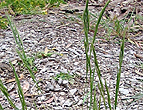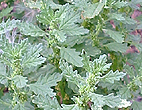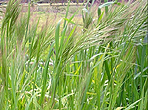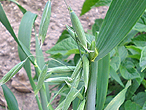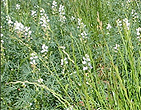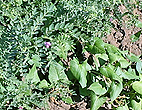module 9
Cropping weeds
Objectives
At the end of this module, you will:
- understand the importance of ecological relationships to weed management systems
- know the components of the weed - crop ecosystem
- understand weed - environment interactions
- know the factors affecting weed - crop associations
- be able to define plant competition and to know what plants compete for
- understand the characteristics that make a plant more competitive
- appreciate the magnitude of crop yield loss and other indirect losses from weeds.
Module outline
- Introduction
- Competition and interference
- Changes in weed flora
- Reproduction, dispersal and seed biology
- Summary
- References and further reading
Introduction
Ecology is the study of interactions between an organism and its environment. In the case of agricultural weeds, the crop is the main component with which interaction or interference takes place. However, human and climatic influences can also be crucial in determining the outcome of crop-weed competition.
Competition and interference
The following reading discusses the main concepts in competition and interference. These processes have a major impact on weed ecology in cropping systems. You should particularly note the discussion of yield loss curves. A considerable expenditure of effort has gone into determining yield loss curves for weeds in a variety of crops. Such curves have been suggested for use as decision aids for farmers (see Black and Dyson 1990 for an example). It is important to realise that competition is the interaction between plants that consume resources (nutrients, light, water) present in a limited supply, whereas interference is a broader term that includes competition, allelopathy, or an interaction with pests and diseases.
|
Changes in weed flora
Weed populations in a given area are dynamic in nature, changing constantly in response to several intrinsic and extrinsic factors. Accidental or deliberate introduction of new species is still a major contributor to our weed problems. Plants have become naturalised in South Australia at an average rate of six species per year since 1802. Some of these are well adapted to the local environment and can quickly become a major weed in their new habitat. Some examples of weedy introductions to Australia are listed below.
Table 9.1. Some weed species introduced into Australia and their place of origin
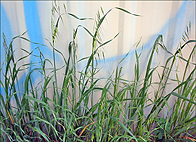 |
The introduction of reduced tillage systems and the reduction of crop rotations has allowed species with little seed dormancy, such as Bromus sterilis, to persist and become major problems. Avena barbata (right) is an example of a weed that is sensitive to cultivation and is therefore found mainly only on undisturbed habitats such as fence-lines and roadsides and rarely found in the cropped area.
Herbicides can also have a major influence on the weed flora. For example, in British agriculture after the introduction of the auxin mimic herbicides in the 1940s, broad-leaved weeds have declined in abundance whilst grass weeds have increased (Figure 6.1). Similar trends are thought to have developed in Australia; however, species shifts are not as well documented.
Figure 9.1. Conjectured changes
in the British arable weed flora over 40 years (after Fryer and
Chancellor, 1970). Broad-leaved weeds (-), grass weeds (--), annual weed problems
(---).
Reproduction, dispersal and seed biology
Now that you have a good appreciation of how weeds interfere with crop production, we will look at why weeds are such a persistent problem in modern agriculture.
For a weed to compete with the crop, its seeds need to survive the Australian hot and dry summers (in the southern Mediterranean climate) or the hot, humid summers (in the northern climate). Germination for an extended period after the break in season (eg. in wild oats) could be an important safeguard against pre-sowing weed kill. After the crop has been sown, the residual weed seed-bank can germinate rapidly enabling the weed population to compete against the crop.
In the following reading by Roberts, all examples used are understandably of European weeds. However, some examples cited, such as wild oats (Avena sterilis ssp. ludoviciana), wireweed (Polygonum aviculare), toadrush (Juncus spp.), etc. are also weeds in southern Australia. Unfortunately, there are no suitable Australian texts on this subject at present. Seed production estimates for some important Australian weed species are presented in Table 6.1. Seed production per plant declines exponentially with increasing plant density (see Module 5).
| Table 9.2. Seed production of various weeds in crops and pastures | ||
| Weed species | Habitat | Seed production (reference) |
| Annual ryegrass (Lolium rigidum) | Wheat | >31,000 seeds m-2 (Rerkasem et al. 1980) 1000 seeds plant-1 |
| Wild oats (Avena fatua, A. sterilis ssp. ludoviciana) | Wheat | 1400-1800 seeds m-2 (Martin & Felton 1993) 5-200 seeds plant-1, depending on weed density (Martin & Felton 1993) |
| Skeleton weed (Chondrilla juncea) | Pasture | 79-820 seeds plant-1, depending on weed emergence date (Panetta 1989) |
| Wild radish (Raphanus raphanistrum) | Wheat | up to 1000 seeds plant-1, or 17,000 seeds m-2 (Reeves et al. 1981) |
| Three cornered jack or doublegee (Emex australis) | Pasture | 5000 seeds m-2 (Gilbey and Lightfoot 1979) |
|
After reading this section on weed reproduction by seed you should be able to discuss:
- ways in which seeds enable weed species to thrive
- amount of weed seed produced by weeds
- mechanisms by which weed seeds are dispersed
- different types of seed dormancy
- role of seed dormancy in the survival of a weed species
- characteristics of the weed seed-bank
- factors affecting germination of weed seeds.
Weeds are generally capable of producing large amounts of seed that can persist in the soil for different lengths of time, depending on the species. In our climate, weed seeds are generally dormant at the time of production, gradually losing their dormancy over the following season. This short-lived dormancy preserves the weed seed-bank from unseasonal germination, for example after a rainfall event.
For annual weeds relying on sexual propagation, seeds allow:
- multiplication of the species - some species can produce enormous amounts of seed. Some local examples of high fecundity are - annual ryegrass, capeweed, and indian hedge mustard
- dispersal of the species (eg. by machinery, crop seed, animals, etc.)
- survival through adverse conditions (eg. hot and dry conditions over summer).
Go to Activity 9-1 |
Summary
Weeds affect crops by:
- competing for resources such as nutrients (e.g. nitrogen), light (shading), and water
- exuding biologically active compounds into the soil that affect growth of their competitors (allelopathy)
- competing with crops and reducing the crop yield - the relationship between weed density and crop yield is exponential in shape
- contaminating harvested grain resulting in dockage (penalty) imposed on the growers delivering contaminated produce.
Weeds are generally capable of producing large amounts of seed. In the Australian climate, seeds of most weed species are dormant at the time of production. Dormancy offers some protection to seeds against unseasonal germination. The presence or absence of light can also enforce dormancy in some weed species. Different weed species are capable of germinating and emerging from varying depths of burial, usually related to their seed size. Bigger seeds can usually germinate and emerge from greater depths in the soil. There are several different biological and physical mechanisms of weed seed dispersal and their relative importance differs from species to species. Weeds are extremely resilient seed producers, ensuring survival of the species in the paddock and an ongoing cost to farmers. Minimising the impact of weeds on agriculture by employing environmentally benign tools is a challenge for weed scientists.
Go to Activity 9-2 | Go to Activity 9-3 |
References and further reading
Cousens, R 1985, ‘A simple model relating yield loss to weed density’, Annals of Applied Biology, vol. 107, pp. 239-252.
Cousens, R & Mortimer, M 1995, ‘Weed population dynamics - the framework’, in Dynamics of weed populations, Cambridge University Press, Cambridge.
Black, ID & Dyson, CB 1990, ‘An economic threshold model for spraying herbicides in cereals’, Weed Research, vol. 33, pp. 279-290.
Fryer, JD, & Chancellor, RJ 1970, ‘Herbicides and our changing weeds’, in The Flora of a Changing Britain, Botanical Society of the British Isles, Report no. 11, pp. 105-118.
Gilbey, DJ & Lightfoot, RJ 1979, ‘Doublegee control in pasture - what is it worth?’, Journal of Agriculture, Western Australia, vol. 20, pp. 21-23.
Martin, RJ & Felton, WL 1993, ‘Effect of crop rotation, tillage practice, and herbicides on the population dynamics of wild oats in wheat’, Australian Journal of Experimental Agriculture, vol. 33, pp. 159-165.
Panetta, FD 1989, ‘Reproduction and perennation of Chondrilla juncea L. (skeleton weed) in the Western Australian wheatbelt’, Australian Journal of Ecology, vol. 14, pp. 123-129.
Poole, ML & Gill, GS 1987, ‘Competition between crops and weeds in southern Australia’, Plant Protection Quarterly, vol. 2, pp. 86-96.
Reeves, TG, Code, GR & Piggin, CM 1981, ‘Seed production and longevity, seasonal emergence, and phenology of wild radish (Raphanus raphanistrum L.)’, Australian Journal of Experimental Agriculture and Animal Husbandry, vol. 21, pp. 524-530.
Rerkasem, K, Stern, WR & Goodchild, NA 1980, ‘Associated growth of wheat and ryegrass. I. Effect of varying total density and proportion in mixtures of wheat and annual ryegrass’, Australian Journal of Agricultural Research, vol. 31, pp. 649-658.
Self assessmentDo you know:
|
